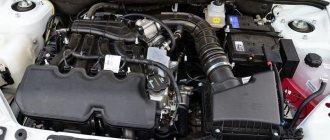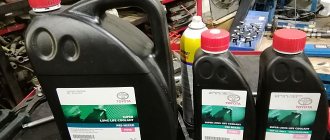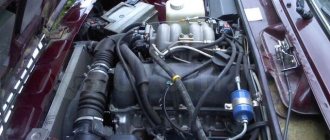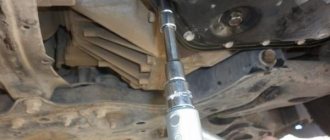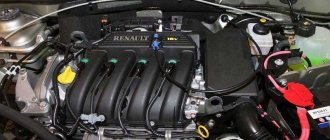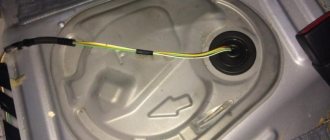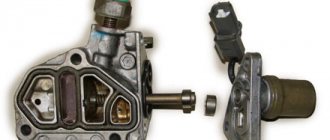By the end of the seventies of the twentieth century, the Toyota company managed to become famous for its products, the characteristics and quality of which, at that time, were not superior to any competitor on the market. By that time, the issue of improving the produced “M” version engines had become ripe.
So, in 79 of the twentieth century, the first engine marked 1G EU (later FE) rolled off the corporation’s assembly line, marking the beginning of a new series. The design of the first engine is simple, intended for installation on rear-wheel drive cars of class “E” and “E+”. Later, the base engine was repeatedly modified, a number of modifications were released, among which the 1G FE received the unspoken title of a reliable unit in the class. New technologies and ideas used on engines were considered innovative for that time, laid the foundation for modern engine construction and became the impetus for further improvement.
Toyota Altezza 1998 year:
Cars with 1G FE
The engine in question was installed on the following car brands:
Toyota Altezza
- From July 2001 to July 2005 on the first generation Toyota Altezza, restyling, station wagon, XE10 body.
- From May 2001 to July 2005 on the first generation Toyota Altezza, restyling, sedan, XE 10 body.
- From October 1998 to April 2001 on the first generation Toyota Altezza, sedan, XE10 body.
Toyota Chaser
- From August 1998 to June 2001 on the sixth generation Toyota Chaser, restyling, sedan, X100 body.
- From September 1996 to July 1998 on the sixth generation Toyota Chaser, sedan, X100 body.
- From September 1994 to August 1996 on the fifth generation Toyota Chaser, restyling, sedan, X90 body.
- From October 1992 to August 1994 on the fifth generation Toyota Chaser, sedan, X90 body.
- From July 1990 to September 1992 on the fourth generation Toyota Chaser, restyling, sedan, X80 body.
- From August 1988 to July 1990 on the fourth generation Toyota Chaser, sedan, X80 body.
Toyota Cresta
- 1From August 1998 to June 2001 on the fifth generation Toyota Cresta, restyling, sedan, X100.
- From September 1996 to July 1998 on the fifth generation Toyota Cresta, sedan, X100 body.
- From September 1994 to August 1996 on the fourth generation Toyota Cresta, restyling, sedan, X90.
- From October 1992 to August 1994 on the fourth generation Toyota Cresta, sedan, X90 body.
- From August 1990 to September 1992 on the third generation Toyota Cresta, restyling, sedan, X80 body.
- From August 1988 to July 1990 on a third generation Toyota Cresta, sedan, X80 body.
Toyota Crown
- From August 2001 to May 2007 on the eleventh generation Toyota Crown, restyling, station wagon, S170 body.
- From August 2001 to November 2003 on the eleventh generation Toyota Crown, restyling, sedan, S170 body.
- From August 2001 to June 2022 on the eleventh generation Toyota Crown, sedan, XS10 body.
- From September 1999 to July 2001 on the eleventh generation Toyota Crown, sedan, S170 body.
- From July 1997 to July 2001 on the tenth generation Toyota Crown, restyling, sedan, S150.
- From July 1997 to August 1999 on the tenth generation Toyota Crown, restyling, sedan, S150.
- From December 1995 to June 1997 on the tenth generation Toyota Crown, sedan, S150 body.
- From July 1995 to June 1997 on the tenth generation Toyota Crown, S150 sedan.
- From August 1993 to July 1995 on the ninth generation Toyota Crown, restyling, sedan, S140 body.
- From October 1991 to November 1999 on the eighth generation Toyota Crown, second restyling, station wagon, S130 body.
- From October 1991 to November 1995 on the eighth generation Toyota Crown, second restyling, sedan, S130 body.
- From August 1989 to September 1991 on the eighth generation Toyota Crown, restyling, station wagon, S130 body.
- From August 1989 to September 1991 on the eighth generation Toyota Crown, restyling, sedan, S130 body.
- From September 1987 to July 1989 on the eighth generation Toyota Crown, station wagon, S130 body.
- From September 1987 to July 1989 on the eighth generation Toyota Crown, sedan, S130 body.
- From September 1987 to July 1989 eighth generation Toyota Crown, sedan, S130 body.
Toyota Mark
- From October 2002 to November 2004 on the ninth generation Toyota Mark II, restyling, sedan, X110 body.
- From October 2000 to September 2002 on the ninth generation Toyota Mark II, sedan, X110 body.
- From August 1998 to September 2000 on the eighth generation Toyota Mark II, restyling, sedan, X100 body.
- From September 1996 to July 1998 on the eighth generation Toyota Mark II, sedan, X100.
- From September 1994 to August 1996 on the seventh generation Toyota Mark II, restyling, sedan, X90 body.
- From October 1992 to August 1994 on a seventh generation Toyota Mark II, sedan, X90 body.
- From August 1990 to August 1996 on the sixth generation Toyota Mark II, restyling, sedan, X80.
- From August 1988 to July 1990 on the sixth generation Toyota Mark II, sedan, X80 body.
- From November 1984 to March 1997 on a fifth-generation Toyota Mark II, station wagon, X70 body.
- From December 2004 to May 2007 on the first generation Toyota Mark II Wagon Blit, restyling, station wagon, X11.
- From January 2002 to November 2004 on the first generation Toyota Mark II Wagon Blit, station wagon, X11 body
Toyota Soarer
From January 1986 to March 1991 on the second generation Toyota Soarer, coupe, Z20 body.
Toyota Supra
From August 1988 to March 1993 on the third generation Toyota Supra, restyling, coupe, A70 body.
Toyota Verossa
From July 2001 to March 2004 on the first generation Toyota Verossa, sedan, X11 body.
Application
The first engines were intended for installation on cars with rear-wheel drive; the goal was to equip cars falling into the “E” and “E+” classes. After successful operation, it was decided to improve the unit for use on other cars. A total of seven generations of the engine have been identified; the list of applications is given in the table below.
What cars was the engine installed on:
Toyota:
- Crown
- Mark 2
- Supra
- Altezza
- Chaser
- Cresta
- Soarer
Lexus:
- IS 200
Lexus IS 200 2005:
Technical data
1G FE - four-stroke, six-cylinder, gasoline engine, with in-line cylinders. The power unit in question has the following technical characteristics:
- manufacturer of this internal combustion engine, Japanese plant Shimoyama plant;
- period of serial production from 1988 to 2007;
- the exact cylinder volume is 1988 cubic centimeters;
- cylinder block material, especially durable cast iron alloy;
- The cylinder head, made of aluminum alloy, has 24 valves; hydraulic compensators are not used here;
- The DOHC type gas distribution mechanism has two camshafts. There are 12 valves on each shaft. One shaft is for the intake of the combustible mixture, the other is for the exhaust gases. There are 4 valves per cylinder, two for exhaust, two for exhaust;
- The timing drive is made by a toothed belt; on internal combustion engines produced after 1998, the engine deforms the valves;
- power system - injector, distributed fuel injection EFI, electronically controlled;
- Contactless ignition system, distributor. After 1998 - DIS 6, each cylinder has an individual ignition coil;
- the engine cylinders operate in the following order: 1, 5, 3, 6, 2, 4;
- The power of this power unit at 5750 rpm is 135,140 hp. For internal combustion engines with VVTi system, produced after 1988 160 hp, power, at 6200 rpm min.
- torque, at its maximum value for rpm 4400, is 176 - 180 Nm. For the internal combustion engine version with a phase regulator, the peak torque at 440 rpm is 200 Nm.
- the cylinder diameter is equal to the piston stroke length of 75 mm., popularly, engines with such parameters are called square, they are distinguished by high efficiency;
- the compression ratio of the combustion chambers is 9.6:1, for internal combustion engines with the VVTi system 10:1;
- compliance with European environmental safety requirements Euro 2, for 1G FE VVTi - Euro 3.
Features of "SuperNail-1GE"
Engine 1jz gte toyota
Fiber network topology
- "point-to-point";
- “point-to-point over one fiber”;
- "ring";
- “redundant ring”;
- “communication over one fiber between several communication points.”
An example of the operation of a point-to-multipoint network using SuperGvozd-1GE and broadband access equipment from other vendors. View the report To organize communication, you can use one or two single-mode or multimode optical fibers (depending on the installed SFP module). To organize communication over one optical fiber, semi-sets are used with an optical receiver and transmitter combined in one SFP transceiver. In this case, transmission and reception in one direction are carried out at different wavelengths of optical radiation, which makes it possible to ensure the maximum possible length of the regeneration section, working on one fiber. The maximum length of the regeneration section depends on the type of optical fiber and the installed SFP module and varies from 10 to 80 km. The minimum length of the regeneration section is zero. Redundancy Equipment semi-sets designed for operation at intermediate communication points provide 100% redundancy of the group stream transmitted over optical fiber, which allows for uninterrupted transmission of the group stream in the event of a fiber break in one of the sections of the fiber-optic line or in the event of a failure food at one of the communication points. Redundancy is provided by 2 SFP optical transceivers and a built-in E1 flow cross-switch. Management Network configuration, control and management of semi-sets is carried out either locally directly at the communication point or remotely using software via the Ethernet interface. Each semi-set has its own IP address specified by the user. From one communication point you can monitor and control all local and remote semi-sets in test mode. Test control mode involves a short-term change (5 minutes) of the semi-set settings. At the end of the test time, all settings set by hardware are restored.
Station Alarm The alarm output is a normally closed and normally open dry relay contact protected by a fuse.
Execution of semi-kits With power supply ~220V or -60V:
| Order code | Product name | Purpose |
| RTC.52.1 | Basic semi-set “SuperGvozd-1GE”, 4 SFP slots, 1Gb Ethernet, 24E1, 12RS-232. Power supply: 60 V. SFP modules must be ordered separately | Ring transmission with redundancy: 24E1, 2 Ethernet 1 Gbit/s each, Ethernet 100Tx - 100 Mbit/s, 12 RS-232 Power supply - 60V. SFP modules must be ordered separately. |
| RTC.52.2 | Basic semi-set “SuperNail-G”, 4 SFP slots, 1Gb Ethernet, 24E1, 12RS-232, AC 220 V Power supply - 220 V, 50 Hz. SFP modules must be ordered separately | Ring transmission with redundancy: 24E1, 2 Ethernet 1 Gbit/s, Ethernet 100Tx - 100 Mbit/s, 12 RS-232 Power supply - 60V. SFP modules must be ordered separately. |
| RTC.52.3 | Basic semi-set “SuperNail-1GE”, 4 SFP slots, 8E1, 12RS-232 Power supply: DC - 60V | Ring transmission with redundancy: 8E1, 2 Ethernet of 1 Gbit/s each, Ethernet 100Tx - 100 Mbit/s, 12 RS-232 Power supply - 60V. SFP modules must be ordered separately. |
| RTC.52.4 | Basic semi-set “SuperNail-1GE”, 4 SFP slots, 8E1, 12RS-232, Power supply: ~220V, 50 Hz OUT OF PRODUCTION. REPLACEMENT - FEED RTC.14.55 | Ring transmission with redundancy: 8E1, 2 Ethernet 1 Gbit/s each, Ethernet 100Tx - 100 Mbit/s, 12 RS-232 Power supply - 220V, 50Hz. SFP modules must be ordered separately. |
| RTC.14.55 | Semi-set board 2 SFP slots 1.25 Gbit/s, 24E1 Power: ~220V, 50 Hz Download description | Ring transmission with redundancy: 24E1+ 4 Ethernet 1Gbit/s each (Ethernet Switch 4×10/100/1000 Mbit/s) 8xE1 allocation. Case with motherboard: width 19″, height 1.5U. Power supply: ~220V, 50 Hz. SFP modules must be ordered separately. |
| RTC 52.5 | Basic semi-set “SuperNail-1GE”, 4 SFP slots, 16E1, 12RS-232 Power: DC - 60V | Ring transmission with redundancy: 16E1, 2 Ethernet 1 Gbit/s each, Ethernet 100Tx - 100 Mbit/s, 12 RS-232 Power supply - 60V. SFP modules must be ordered separately. |
| RTC 52.6 | Basic semi-set “SuperNail-1GE”, 4 SFP slots, 16E1, 12RS-232, AC 220V | Ring transmission with redundancy, SFP: 16E1, 2 Ethernet 1 Gbit/s each with SFP, Ethernet 100Tx - 100 Mbit/s, 12 RS-232 Power supply - 220V, 50Hz. SFP modules must be ordered separately. |
For multiplexer configuration, we offer you a large selection (more than 200 models) of reliable SFP modules.
Certificate of conformity: No. OS-1-SP-1539 until 07/04/2020
A little history
Initially, the G ICE series was conceived as an alternative to the outdated M series engines. In 1979, the new engine was put into mass production and finally replaced the alternative model. We are talking about a six-cylinder 1G EU engine. It is very well suited for E class cars with rear wheel drive. The engine performed well, its power at 5400 rpm was 125 hp, and the maximum torque at 4400 rpm corresponded to 160 Nm.
It was replaced by a modification of the G series, an engine with 24 valves 1G FE. The engine volume remains the same, 2 liters. The main difference from its older brother was the new cylinder head and DOHC type gas distribution mechanism with two camshafts. This made it possible to increase power by 10 hp, and raise torque to 176 Nm. This power unit has long been considered the most successful and reliable among similar engines.
In 1996, the internal combustion engine underwent minor changes, which resulted in an increase in power by 5 hp. And two years later, big changes awaited the engine. Then the sports Toyota Altezza required an engine of a similar configuration, but with better technical characteristics.
Toyota engineers solved this issue by increasing the engine speed and increasing the compression ratio in the combustion chambers. For this, the cylinder head received a number of electronic, new devices. Other mechanisms and parts have also undergone changes. As a result, the naturally aspirated engine began to produce a power of 160 hp, and the peak torque was 200 Nm. Due to changes in the design of the piston group, the engine received one drawback.
When the toothed belt broke, the engine began to deform the valves. In this form, 1G FE was mass-produced until 2007. Production of this motor continued for several years, in limited quantities.
Device and design
1G FE is a gasoline, four-stroke engine with in-line six cylinders. The cylinder block of this engine is made of cast iron alloy; it is possible to bore the cylinders and carry out major engine repairs, thanks to which the engine in question can, without exaggeration, be called a millionaire.
Cylinder head device
The prototype of 1G FE is its older brother 1G EU. To get a new engine, the designers completely modernized the cylinder head. Instead of one camshaft and 12 valves, the head design of the new engine included two camshafts and 24 valves. On the 12-valve head, the thermal clearances of the valves were regulated by hydraulic compensators; they were not used in the new design. Because of this, it became necessary to periodically adjust the valves. Fuel injection is now controlled by a MAP sensor. Distributor ignition system.
Timing drive
The timing mechanism is driven by a toothed belt from the crankshaft pulley to the pulley of one camshaft. The other timing shaft is driven from the first one through a gear transmission. The timing belt, in addition to the camshaft, drives other attachments: oil pump, pump, etc. For this reason, it carries a large load. The service life of the toothed belt, declared by the manufacturer, is 100 thousand km. However, in reality it fails earlier. Therefore, the timing belt must be replaced before the replacement schedule specified by the manufacturer. The only good thing is that the engine does not damage the valves when the timing belt breaks.
Refinements and improvements to the engine design
During the production period, the engine in question was repeatedly changed in design. The first, minor modernization took place in 1996. The design of the motor has not undergone major changes. The changes affected, to a greater extent, the electronics settings. As a result, the internal combustion engine gained 5 hp in power, strength and the same amount in torque.
Much bigger changes awaited the power unit in 1998. 1G FE has been modernized so much that it can be considered a completely different internal combustion engine. The only thing that remains unchanged in all modifications is the engine cylinder capacity.
The engine received a completely new piston group, which is why it lost its status as the most reliable engine. When the timing belt broke, the engine began to damage the valves. The crankshaft has also undergone improvements. But the piston stroke was left the same. An automatic system was installed on the intake camshaft that changed the valve timing. The throttle valve is electronically controlled. The distributor in the ignition system was replaced by DIS-6. This system is represented by a separate coil for each cylinder. The intake manifold has a modified ACIS geometry.
The modernization carried out contributed to an increase in power to 160 hp, power, and torque to 200 Nm.
Tuning
The engine design is not suitable for modifications. The only version suitable for tuning is the GTE series engine. A controller is installed on the unit, allowing the boost pressure to be increased to 1.1-1.2 bar. To cool the compressed air, a front radiator is used, mounted in front of the heat exchanger of the cooling system. Increasing the boost requires the use of a more efficient fuel pump and injectors; it also requires replacing the injection control unit with a modernized one.
The maximum power of the modified engines is 300 hp. while preserving the resource and the possibility of everyday use of the car. Further refinement involves the abandonment of 2 compressors in favor of 1 with increased productivity. To ensure performance, it is necessary to install a new piston group, which will reduce the compression ratio. The disadvantage of this modification is the high labor intensity and cost.
- Engine disassembly
- Acceleration 0-100 km/h (Toyota Mark II)
- Cold start
Toyota 1G internal combustion engine modifications
- 1G EU is the first basic model of the G series. The compression ratio of the combustion chambers of this internal combustion engine is 8.8:1, maximum power at 5400 rpm min., 125 hp, hp. The torque at 4400 was 160 hp. The production continued until 1998. Then it was replaced by the engine discussed in this article.
- The 1G GEU is a version of the base engine with a Yamaha 24-valve cylinder head and an exhaust manifold that has an adjustable T-VIS geometry. This design contributed to an increase in power at 6400 rpm, up to 160 hp. The modification was carried out from 1983 to 1988.
- The 1G GTEU is a turbocharged version of the previous engine. This modification was equipped with two turbines of the ST12 type. At a pressure of 0.5 bar, the engine produced a power of 185 hp. Torque at 3200 rpm min., 245 Nm. The model was produced from 1986 to 1988.
- 1G GZEU - version of 1G-GEU, which uses an SC-14 compressor instead of two turbines. The piston group has been changed here and electronic ignition is used. The power of this model at 6000 rpm is 160 hp. And the torque at 4000 rpm is 210 hp. In 1989, the modification was modernized, the compressor boost was increased to 0.5 bar. At the same time, the power was 170 hp, and the torque was 230 Nm. The version was released from 1986 to 1992.
- 1G GE - version of 1G-GEU, where DBP was installed instead of the mass air flow sensor. At the same time, the power decreased to 150 hp, and the torque was 186 Nm. The motor was produced from 1988 to 1993.
- 1G-GTE - turbocharged version with a reinforced crankshaft, intercooler, modified intake, 315 cc injectors, ECU. The turbine pressure increased to 0.75 bar. The power was 210 hp, and the torque was 275 Nm. This modification was produced from 1988 to 1991.
- 1G-FE is a modification of the basic internal combustion engine, which is discussed in this article.
Typical malfunctions and ways to eliminate them
1G FE is deservedly considered a very reliable power unit, but it also has weaknesses. This is especially true for internal combustion engines produced after modernization in 1998:
Timing belt wear
The engine was last modernized in 1988 and underwent a change in the design of the piston system. As a result, there was a danger of collision of pistons with valves when the timing belt breaks.
The toothed belt has a service life of 100 thousand km. But there are known cases of its failure after 80 thousand km. Therefore, in order not to provoke expensive repairs, it is necessary to replace the timing belt after 70 thousand kilometers.
Oil pressure sensor
With this modification, problems often arise with the oil sensor. It may indicate incorrect engine oil pressure. To fix the problem, you need to check the pressure in the oil system using a pressure gauge. If incorrect operation is confirmed, the sensor must be replaced.
It is also possible that engine lubricant may leak due to wear of the oil pressure sensor. Here the sensor also needs to be replaced.
Zhor oil
This engine is characterized by increased consumption of motor lubricant. This happens most often after a decent mileage. The reason here may be the occurrence of oil scraper rings. The problem can be corrected by decoking or repairing the piston group with the installation of new piston rings. It is important not to forget to change the valve seals. Through them, after a long mileage, oil, as a rule, enters the cylinders.
Electronics failures
Unstable operation of the internal combustion engine, floating speed, these are all signs of electronic malfunctions. To combat such problems, you need experience in solving similar problems and special equipment. If there is nothing like this, then it is better to immediately contact the service center.
Power Loss
A sure sign of failure of the VVTi system. It's all about contamination of the VVTi valve plunger. Slag gets clogged there and the valve plunger jams. The deslag removal procedure will return the motor to its former agility.
Search for knocks
Heirs
The company's plans were to replace the Toyota 1G engine with the 1JZ unit that appeared in 1990. However, 1G-FE and 1G-FE BEAMS remained on the production line for about 15 more years in parallel with JZ. The latter were never able to supplant the 1Zh series, until they were both supplanted by the V-shaped power unit of the GR series. At this point, the time of the “folk” inline sixes has sunk into oblivion.
The conservative Crown Sedan began to be content with the modest four of the TR series, and V-shaped GR (ZhR) were used on “marque” (categories C, D, E), vans, large SUVs, medium and heavy pickups and jeeps. Table 2 characterizes the working volume of engines of the ZhR generation.
Table 2. Displacement of engines that replaced 1Zh
| Modification | Execution | Volume, l |
| 1 | GR FE | 4,0 |
| 2 | GR FE, FKS, FSE, FXE, FZE | 3,5 |
| 3 | GR FE and FSE | 3,0 |
| 5 | GR FE | 2,5 |
Even professionals at repair centers, who believe that the deep modernization of 1998 had a negative impact on the maintainability and durability of the unit, recognize the high degree of reliability of both engine options: simple FE and FE BEAMS. Reviews from ordinary car owners regarding these engines are mostly positive.
Operational Maintenance
Proper maintenance of the internal combustion engine contributes to a long service life of the power unit. And improper maintenance can kill it in a very short period of operation. 1G FE is subject to the following operational maintenance:
- The most important and frequent maintenance activity is changing the engine oil. This engine, created after 1998, is equipped with a variable valve timing system. The operation of the clutch is carried out using engine oil pressure. Because of this, the engine is very demanding on the quality of oil. Therefore, it makes sense to shorten the oil change period by 10 thousand km, recommended by the manufacturer. It needs to be reduced to 7 thousand, km, mileage. The oil volume in the engine is 4.8 liters, 4.3 liters are enough for replacement. The types of oil used by viscosity are 5w40, 5w30.
- Spark plugs have a service life of 20,000 km, then they should be replaced with new ones.
- The air and fuel filters must be replaced after 40 thousand km.
- Antifreeze needs to be changed every 40,000 km.
- The auxiliary belt must be replaced after 60 thousand km. During the same period, the timing belt should be changed. Since the declared resource is 100 thousand km, it rarely works. And if the teeth break or jump, the valves are deformed.
- Every 100 thousand km, the valves should be adjusted. On versions without a phase regulator, valve adjustment is performed by selecting washers. And on models with VVTi, adjustment is more complicated, using the selection of pushers.
Our offer
You can purchase a contract Toyota 1G-FE engine at an attractive price if you contact. We specialize in direct supplies of spare parts and components for foreign-made cars directly from Japan and Europe. We cooperate only with trusted suppliers and independently form batches of units that are in high demand. Our warehouses are located in Moscow, St. Petersburg, Novosibirsk, Irkutsk, Krasnoyarsk, and a number of other Russian cities. All engines that go on sale undergo a mandatory procedure for checking their technical condition at professional stands. By purchasing a unit from us and installing it in our service, you will receive a guarantee for a period of up to 100 days. All license plates are accompanied by documents that will allow you to go through the state procedure without any problems. registration with the traffic police.
To select the power unit you need from those available and fill out the order form, visit our catalog page: https://torens-auto.com/catalog/dvigatel_v_sbore/filter/torgovaya_marka-is-toyota/dvigatel-is-1g-fe/ apply/.
By calling +7 499 288 06 34 with additional questions, you can receive any necessary information.
Negative and positive sides
Disadvantages of the internal combustion engine under consideration
Each power unit, even one as reliable as 1GFE, has its drawbacks. Take fuel consumption, for example. So in urban areas, consumption ranges from 14 to 11.5 liters, depending on the class of the car. For a two-liter car with a timing belt - DOHC, this is a very large indicator.
A lot has already been said about the fact that on models with the VVTi system installed, the engine bends the valves. This is a serious drawback. But if you don’t wait, the guaranteed service life of the timing belt is 1000 thousand km. And if you change it after 60 - 70 thousand km, then you may have to avoid troubles. However, here lies another negative side of the engine. The toothed belt, in addition to the timing mechanism, drives the oil pump. During severe frosts in winter, engine oil can become so thick that it causes the belt teeth to cut off. Which can lead to teeth slipping with a very short service life of the timing belt. This is a much bigger drawback that needs to be paid special attention to.
It also cannot be considered an advantage to regularly check the thermal clearances in the valves, as well as adjust them every 100 thousand km. This task is especially troublesome on an internal combustion engine with a phase regulator installed. Here the gap is adjusted by selecting expensive pushers. On an engine without a VVTi system, everything is much simpler: adjusting the valve clearances is done by selecting washers.
Another serious drawback is increased oil consumption. Many experienced specialists consider this problem to be a design flaw. This is proven by the fact that consumption of up to 1 liter per 1000 km is considered to be the norm. But then, why can’t a consumption of 1.2 liters of oil per 1000 km be considered the norm, because this is not a significant difference. The reason for oil consumption is classic: wear of the piston group, failure of oil removable caps.
